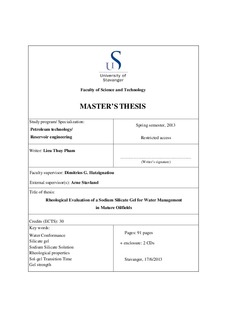| dc.contributor.author | Pham, Lieu Thuy | |
| dc.date.accessioned | 2014-02-06T08:10:09Z | |
| dc.date.issued | 2013 | |
| dc.identifier.citation | | no_NO |
| dc.identifier.uri | http://hdl.handle.net/11250/183642 | |
| dc.description | Master's thesis in Petroleum engineering | no_NO |
| dc.description.abstract | Excess water production is a common problem in mature and hydrocarbon rate declining oil and gas fields. Increased water production rates reduce oil and gas production, increase the cost related with fluid lifting, handling and disposal of produced water and negatively impacts the hydrocarbon production economics. Among the various techniques for water control, silicate gel system is known to be an effective and environmentally friendly method for water shutoff treatment. This gel system usually contents two main components, which are the liquid silica and activator. The system that has a low viscosity (almost like water) is mixed and pumped from surface in liquid form. The gelation time has been designed to be delayed under reservoir conditions thus allowing sufficient time for the pumped fluids to reach the designated distance from the treatment well. After certain time, a hard gel is formed that blocks high permeable zones and eliminate unwanted flow of water towards the production wells.
This thesis focuses on the laboratory qualification of a sodium silicate gel system for designing and implementing water shutoff treatments in the field. Lab rheology measurements were carried on sodium silicate gel samples using the Anton Paar Rheomter MCR302. Two test modes were run with the specific purposes: the Dynamic-Mechanical (DMA) mode is employed to determine the onset of the gelation (sol-gel transition time or gel point) and the viscosity increase versus time; the Amplitude sweep mode is used to assess the formed gel’s shear strength at a given viscosity. Gel point and gel strength play an important role in designing successful water shutoff treatments since the first determines the required time for injecting the gelant system into the reservoir and other determines the force the formed gel can withstand under shear conditions.
The effects of silicate and activator concentrations, presence of divalent ions (e.g., Ca2+, Mg2+), temperature, and gelant dilution on sol-gel transition time were investigated. A general equation, which describes the relation between sol-gel transition times with all mentioned factors, was developed for field application’s design later. | no_NO |
| dc.language.iso | eng | no_NO |
| dc.publisher | University of Stavanger, Norway | no_NO |
| dc.relation.ispartofseries | Masteroppgave/UIS-TN-IPT/2013; | |
| dc.subject | petroleumsteknologi | no_NO |
| dc.subject | reservoarteknologi | no_NO |
| dc.subject | water conformance | no_NO |
| dc.subject | silicate gel | no_NO |
| dc.subject | sodium silicate solution | no_NO |
| dc.subject | rheological properties | no_NO |
| dc.subject | sol-gel transition time | no_NO |
| dc.subject | gel strength | no_NO |
| dc.title | Rheological evaluation of a sodium silicate gel for water management in mature oilfields | no_NO |
| dc.type | Master thesis | no_NO |
| dc.subject.nsi | VDP::Technology: 500::Rock and petroleum disciplines: 510::Petroleum engineering: 512 | no_NO |
| dc.description.embargo | 2015-06-15 | |
